Nosferatu the Vampyre

Description:
Nosferatu the Vampyre is a haunting and atmospheric retelling of the classic Dracula tale. Set in 19th century Germany, the film follows the eerie journey of Count Dracula as he preys on the unsuspecting townspeople. With stunning visuals and a chilling performance by Klaus Kinski, this film is a must-see for fans of horror and suspense.Keywords:
Atmosphere, Gothic, Isolation, Existential, HauntingWhich Dracula movie was banned?
"Nosferatu the Vampyre" (1979), directed by Werner Herzog, is an adaptation of Bram Stoker's "Dracula." It was not banned; however, the original 1922 silent film "Nosferatu," directed by F.W. Murnau, faced legal issues due to copyright infringement of Stoker's work and was effectively banned in some regions after a court ruling ordered all copies to be destroyed. The 1979 film is considered a classic and reinterprets the story with a unique artistic vision.
What is Nosferatu the Vampyre about?
"Nosferatu the Vampyre," directed by Werner Herzog, is a 1979 reimagining of F.W. Murnau's 1922 silent film "Nosferatu." The story follows Jonathan Harker, a young estate agent who travels to Transylvania to assist Count Dracula in purchasing a property in Wismar, Germany. He soon discovers that the Count is a vampire, and his arrival brings a plague of fear and death to the town. The film explores themes of obsession, isolation, and the nature of evil, featuring Klaus Kinski as the haunting Count and Isabelle Adjani as Lucy Harker.
Which Nosferatu movie was banned?
"Nosferatu the Vampyre," directed by Werner Herzog and released in 1979, is a reimagining of F.W. Murnau's 1922 silent classic "Nosferatu." The original film faced legal issues and was effectively banned in certain regions after Bram Stoker's estate sued for copyright infringement. The courts ordered that all copies be destroyed, making it a rare artifact. However, "Nosferatu" has since gained recognition as a seminal work in horror cinema, with many surviving copies preserved and celebrated today.
Is Nosferatu a queer film?
"Nosferatu the Vampyre," directed by Werner Herzog in 1979, can be interpreted through a queer lens due to its themes of alienation, desire, and the subversion of traditional gender roles. The film presents Count Dracula (Nosferatu) as a figure of both attraction and repulsion, embodying a form of otherness that resonates with queer experiences of marginalization. The complex, often intimate dynamics between characters, particularly between Jonathan Harker, Lucy, and Nosferatu, can also suggest deeper, non-normative relationships, contributing to its queer readings.
Explore More Categories:
Illusion Experiment Corporate Basketball Interviews Quarter Life Crisis Performance Disconnection Wildlife Entrepreneurship Time Travel Financial Crisis Herbert West Transformation Knighthood Tradition Practical Effects Remake Anxiety Social Change 1960s Everyday Life Mammoths Mortality Investigative